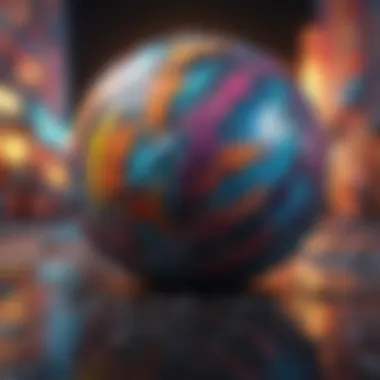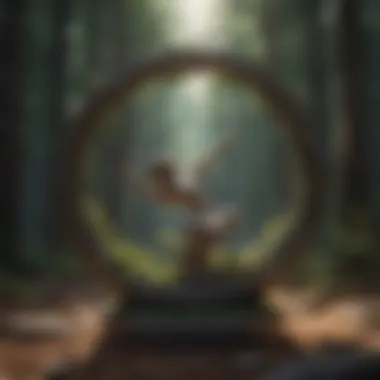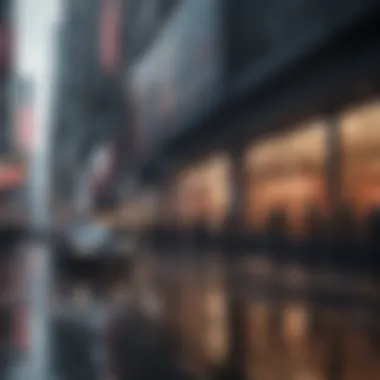Unveiling the Intriguing World of Artists: A Comprehensive Exploration


Strategies for Success
Artists, like many creative individuals, often follow specific strategies to achieve success in their endeavors. Despite the perception of the unpredictable nature of the artistic field, setting clear goals is a foundational technique for artists. By establishing tangible objectives, artists can navigate their creative journey with purpose and direction, ensuring that each artwork contributes meaningfully to their overall artistic vision. Effective time management is another crucial aspect that artists employ to balance the demands of artistic creation with other life commitments. By allocating time efficiently to different stages of the artistic process, artists can maximize productivity and maintain a sustainable workflow. Additionally, artists may embrace productivity hacks to streamline their creative workflow, leveraging techniques and tools to enhance efficiency and artistic output.
Leadership Psychology Insights
While the artistic domain may not appear immediately connected to traditional leadership roles, leadership psychology insights can offer valuable perspectives for artists. Emotional intelligence plays a pivotal role in artistic endeavors, enabling artists to navigate complex emotions, form connections with their audience, and manage relationships within the artistic community. Effective communication skills are essential for artists to convey their artistic vision clearly and engage with viewers on a deeper level. Moreover, team building strategies can be relevant for artists collaborating with other creatives or seeking to build a supportive network within the artistic community.
Personal Growth and Development
Personal growth and development are intrinsic to an artist's journey, shaping both their artistic output and personal well-being. Mindset shifts for success involve cultivating a positive and growth-oriented mindset that enables artists to overcome challenges and embrace opportunities for artistic growth. Self-care practices are vital for artists to maintain their well-being amidst the inherent emotional intensity of the artistic process. By prioritizing self-care activities such as mindfulness practices, exercise, and social connections, artists can sustain their creative energy and mental health. Furthermore, overcoming challenges and adversities is a common theme in artists' experiences, providing opportunities for growth, resilience, and artistic breakthroughs.
Business Growth Strategies
In today's dynamic artistic landscape, artists are increasingly adopting business growth strategies to establish their brand, reach a wider audience, and sustain their creative practices. Marketing and branding strategies are crucial for artists to promote their artwork effectively, communicate their artistic identity, and connect with potential buyers or patrons. Sound financial management practices enable artists to manage their artistic finances competently, make informed decisions about pricing and investments, and ensure financial sustainability in the long term. Innovation and entrepreneurship are pivotal for artists seeking to explore new avenues for creativity, tap into emerging markets, and transform unconventional ideas into profitable artistic ventures.
Case Studies and Real-Life Examples
Beyond theoretical frameworks and strategies, case studies and real-life examples offer practical insights and inspiration for artists navigating the complexities of the artistic industry. Success stories of entrepreneurs in the artistic realm showcase diverse paths to success, shedding light on innovative approaches, adaptive strategies, and the critical role of perseverance in achieving artistic goals. Leadership lessons from industry experts provide valuable mentorship for artists, offering firsthand experiences, wisdom, and practical advice on navigating the artistic landscape. Business turnaround case studies highlight the resilience, strategic decision-making, and transformative initiatives undertaken by artists facing challenges, setbacks, or industry shifts, inspiring artists to adapt, innovate, and thrive in a rapidly evolving artistic environment.
Introduction
In this article, we embark on an insightful journey into the intricate world of artists, aiming to illuminate their distinct perspectives, innovative processes, and the profound impact of their creations on society. By delving into the artist's evolution, creative influences, societal relevance, and enduring legacy, we seek to offer a holistic understanding of the life and work of these talented individuals.
Defining an Artist
Artistic Vision and Expression
Artistic Vision and Expression stand as pivotal elements shaping the identity of an artist. The intricate interplay between vision and expression forms the artistic core, driving the creation of captivating works. Understanding an artist's unique vision provides a gateway to comprehending the depth and soulfulness embedded within their artistry. Through this exploration, we unveil how artists utilize their distinctive vision to communicate narratives, emotions, and concepts, fostering a profound connection with viewers.


Role in Society
The artist's role in society transcends mere creators of aesthetic objects; they serve as cultural mirrors, social critics, and catalysts for change. Artists wield their creations as tools for reflection, sparking dialogue, provoking thought, and challenging societal norms. By analyzing an artist's impact on societal consciousness, we illuminate the profound influence artists exert in shaping perspectives, promoting empathy, and inciting dialogue on pertinent social issues.
Artistic Mediums
Artistic Mediums serve as the tangible conduit through which an artist's vision and expression manifest into reality. From traditional mediums like oil on canvas to avant-garde forms encompassing digital art and installations, each medium bestows distinct opportunities and challenges. Exploring the diverse landscape of artistic mediums unveils the versatile nature of artists, emphasizing the significance of medium selection in conveying intended messages and evoking desired emotions.
Evolution of Artistry
Historical Perspective
The Historical Perspective of artistry offers a lens into the evolution of artistic practices, ideologies, and aesthetics across different epochs. By tracing the historical lineage of art movements, styles, and techniques, we decipher the underlying motifs that have shaped contemporary artistry. Understanding the historical context empowers us to appreciate the rich tapestry of influences that have culminated in the diverse artistic expressions witnessed today.
Modern Influences
Modern Influences encapsulate the dynamic interactions between contemporary socio-cultural milieu and artistic endeavors. Artists navigate a confluence of global trends, technological advancements, and intercultural dialogues, reshaping the landscape of modern artistry. By dissecting these modern influences, we unravel the complexities that underpin creative processes, innovation, and adaptability in the ever-evolving realm of contemporary art.
Technological Advancements
Technological Advancements herald a new era in artistic innovation, equipping artists with tools and platforms to push the boundaries of creativity. From digital art platforms to virtual reality immersive experiences, technology revolutionizes how artists conceive, produce, and exhibit their creations. Delving into technological advancements unveils how artists leverage digital tools, algorithms, and interactive mediums to redefine artistry, engage audiences, and transcend traditional boundaries.
The Artist's Journey
In delving into the realm of artists, it is essential to grasp the significance of 'The Artist's Journey' within the broader context of this article. This section serves as a pivotal exploration of the pathway that artists embark upon from their nascent stages to the pinnacle of their creative endeavors. By dissecting the early influences, creative processes, and overarching challenges faced by artists, we unravel the intricate layers that shape their artistic identity and contribute to the evolution of their craft. Understanding 'The Artist's Journey' offers invaluable insights into the transformative odyssey that artists traverse in honing their skills, refining their vision, and leaving an indelible mark on the artistic landscape.
Early Influences
Education and Training
Education and Training represent foundational pillars in the edifice of an artist's journey. Through formal education or specialized training programs, aspiring artists acquire essential skills, theoretical knowledge, and practical techniques that lay the groundwork for their artistic pursuits. The structured learning environment not only imparts technical proficiencies but also fosters critical thinking, experimentation, and the cultivation of a unique artistic voice. Education and Training, with its structured curriculum and experienced instructors, provide aspiring artists with a solid foundation to navigate the complexities of the art world and refine their craft towards mastery.


Mentorship and Inspiration
Central to the artist's journey is the symbiotic relationship between Mentorship and Inspiration. Mentors, seasoned artists, or industry professionals, offer guidance, support, and wisdom gleaned from their experiential journey, nurturing the budding talents of proteges. Inspirations, ranging from personal experiences to external stimuli, fuel the creative fire within artists, propelling them to explore new horizons, experiment with innovative techniques, and push the boundaries of artistic expression. Mentorship and Inspiration act as catalysts in shaping an artist's perspective, fostering growth, resilience, and a deeper understanding of their creative impulses.
Creative Process
Ideation and Conceptualization
At the heart of the creative process lies Ideation and Conceptualization, wherein artists conceive and develop the underlying ideas and themes that form the bedrock of their artistic endeavors. Ideation involves brainstorming, researching, and introspection to generate novel concepts and innovative approaches to artistic expression. Conceptualization, on the other hand, entails refining and structuring these ideas into coherent frameworks that resonate with the artist's vision and intention. The synergy between Ideation and Conceptualization fuels the creation of profound, thought-provoking artworks that encapsulate the artist's unique perspective and creative ingenuity.
Execution and Iteration
Execution and Iteration represent the iterative stages through which artistic ideas materialize into tangible works of art. Execution involves the hands-on application of artistic techniques, mediums, and tools to translate conceptualized ideas into physical or visual forms. Iteration, conversely, denotes the process of refining, revising, and reimagining the initial concept through repeated cycles of experimentation and introspection. The marriage between Execution and Iteration fosters artistic growth, innovation, and refinement, culminating in the meticulous craftmanship and distinct aesthetic signature of the artist's creations.
Challenges and Breakthroughs
Embedded within the creative process are the twin forces of Challenges and Breakthroughs that test the artist's resilience, creativity, and adaptability. Challenges, be they technical, conceptual, or external, present obstacles that demand creative problem-solving, resourcefulness, and unwavering determination. Breakthroughs, on the other hand, mark transformative moments of epiphany, innovation, or success that propel the artist to new heights of artistic achievement and self-discovery. Navigating through a terrain fraught with challenges and embracing breakthroughs are integral facets of an artist's journey, shaping their artistic identity, fortifying their resolve, and propelling their creative evolution.
Artistic Impact
Artistic Impact holds significant prowess within the scope of this engrossing piece. It serves as a pivotal section that delves deeply into the intricate web of influences artists have on society. Understanding the essence of Artistic Impact allows one to grasp the transformative power that emanates from a single stroke of a brush, a lyrical dance move, or a captivating scene in a film. This section unravels the layers of complexity involved in shaping perceptions, triggering emotions, and sparking critical dialogues through artistic expressions. By dissecting Artistic Impact, readers are offered profound insights into the dynamic interplay between creativity and culture.
Influence on Society
Cultural Reflection
Cultural Reflection within the artistic realm exudes a mesmerizing allure that captivates audiences worldwide. Artists harness the power of cultural reflections to infuse authenticity, diversity, and richness into their creations. This subsection meticulously dissects the nuances of cultural reflection, showcasing how artists draw inspiration from heritage, tradition, and societal norms to craft compelling narratives that resonate across borders. By scrutinizing the impact of cultural reflections, readers gain a profound understanding of how art serves as a mirror reflecting the complexities and beauty of diverse cultures.
Social Commentary
Social Commentary stands as a beacon of enlightenment within the realm of artistic discourse. Artists keenly observe and critique societal structures, norms, and injustices through their work, provoking viewers to reflect on prevailing issues and contemplate avenues for change. This segment meticulously examines the role of social commentary in art, highlighting the significance of art in challenging the status quo, advocating for marginalized voices, and fostering meaningful dialogues on pressing social matters. By exploring the facets of social commentary, readers are encouraged to view art not merely as an aesthetic indulgence but as a potent catalyst for social change.


Emotional Connection
Emotional Connection serves as the lifeblood of artistic expression, forging intimate bonds between creator and audience. Artists strive to evoke a myriad of emotions – be it joy, sorrow, nostalgia, or empathy – in their viewers, fostering deep connections that transcend geographical and cultural barriers. This division meticulously dissects the intricate art of stirring emotions through artistic endeavors, elucidating how artists craft narratives that resonate at a visceral level with individuals worldwide. By unraveling the threads of emotional connection, readers embark on a poignant journey into the transformative power of art on human sentiments.
Contributions to Art Movements
Abstract Expressionism
Abstract Expressionism emerges as a groundbreaking movement that redefined artistic paradigms in the 20th century. This genre liberated artists from traditional constraints, enabling them to express raw emotions and abstract concepts through bold brushstrokes and vivid colors. By exploring the depths of abstract expressionism, readers immerse themselves in a world where spontaneity, individuality, and emotional fervor reign supreme, igniting new perspectives and igniting the flames of creativity.
Surrealism
Surrealism emerges as a realm where reality intertwines with dreams, subconscious desires, and fantastical imagery. Artists delve into the recesses of the mind, creating surreal landscapes that challenge conventional perceptions and beckon viewers into a realm of subconscious exploration. By navigating the landscapes of surrealism, readers embark on a surreal journey where logic surrenders to imagination, inviting contemplation on the mysterious realms of the psyche and the boundless horizons of creativity.
Minimalism
Minimalism epitomizes the essence of 'less is more,' stripping art to its bare essentials and unveiling profound beauty in simplicity. Artists embrace minimalism as a quest for purity, clarity, and precision, eliminating excesses to amplify the impact of subtle forms, hues, and compositions. This segment delves deep into the minimalist ethos, exploring how artists wield simplicity as a potent tool to provoke contemplation, evoke serenity, and redefine perceptions of space and form. By unraveling the minimalist aesthetic, readers are ushered into a realm where silence speaks louder than words, inviting reflection on the profound beauty of understatement.
Recognition and Legacy
When delving into the topic of Recognition and Legacy in the context of artistry, we uncover a vital aspect that shapes the lasting impact of an artist's work on society and future generations. Recognition not only acknowledges the talent and effort invested by artists but also serves as a validation of their artistic prowess. Legacy, on the other hand, transcends the artist's lifetime, carrying forward their influence and contributions to art movements. Understanding the significance of Recognition and Legacy in this comprehensive guide sheds light on the enduring power of art to foster cultural dialogue and emotional resonance.
Artistic Recognition
Artistic Recognition plays a pivotal role in elevating an artist's profile and cementing their place in the annals of art history. Awards and Accolades serve as tangible symbols of achievement, propelling artists into the spotlight and granting them opportunities for further creative exploration. The allure of Awards and Accolades lies in their ability to showcase excellence and innovation within the artistic domain, providing artists with prestigious platforms to amplify their artistic voice. While Awards and Accolades can enhance an artist's visibility and credibility, they also come with the pressure to maintain a standard of artistic brilliance amidst a competitive landscape.
Critical Acclaim
Critical Acclaim functions as a barometer of an artist's impact on art criticism and public reception. It signifies the recognition and appraisal of an artist's work by esteemed critics and audiences alike, shaping perceptions and interpretations of artistic value. The essence of Critical Acclaim lies in its ability to spark discourse, generate awareness, and prompt introspection within the art community. While garnering Critical Acclaim can validate an artist's creative choices and thematic resonance, it also exposes them to the scrutiny of diverse opinions and perspectives, fostering a dynamic dialogue around their artistic endeavors.
Enduring Influence
Enduring Influence encapsulates the long-term effects of an artist's work on the artistic landscape and cultural zeitgeist. Artistic Legacy embodies the imprint left by an artist through their innovative techniques, thematic explorations, and distinct aesthetic sensibilities. It serves as a blueprint for future generations, guiding aspiring artists in their creative pursuits and fostering a sense of continuity within art movements. The valorization of Artistic Legacy lies in its ability to transcend temporal boundaries, resonating with audiences across diverse eras and societal contexts.
Inspiration for Future Generations
Inspiration for Future Generations acts as a beacon of creativity and ingenuity, propelling emerging artists to push boundaries and challenge conventions. It instills a sense of awe and admiration for the artistic achievements of past luminaries, fueling a cycle of innovation and reinterpretation in contemporary art practices. The essence of Inspiration for Future Generations lies in its ability to foster a sense of interconnectedness and shared creative heritage, empowering emerging talents to carve their unique artistic trajectories amidst a rich tapestry of artistic influences.



